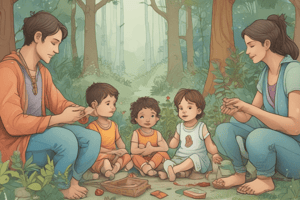Podcast
Questions and Answers
What is a primary benefit of collaboration among children in early childhood settings?
What is a primary benefit of collaboration among children in early childhood settings?
- Improvement of fine motor skills
- Enhancement of individual learning styles
- Increased competitiveness
- Development of social skills (correct)
Which activity is likely to foster collaboration among children?
Which activity is likely to foster collaboration among children?
- Silent reading time
- Solo nature walks
- Building with blocks in a group (correct)
- Individual art projects
Which of the following is NOT a method to accommodate various learning styles in early childhood activities?
Which of the following is NOT a method to accommodate various learning styles in early childhood activities?
- Modifying activities for diverse needs
- Offering choices within activities
- Including auditory and kinesthetic elements
- Providing only visual materials (correct)
How do cooking or baking projects promote collaboration among children?
How do cooking or baking projects promote collaboration among children?
Which activity involves children contributing to a collective project?
Which activity involves children contributing to a collective project?
What is an example of an activity that promotes critical thinking and problem solving?
What is an example of an activity that promotes critical thinking and problem solving?
Circle time discussions help children develop which of the following skills?
Circle time discussions help children develop which of the following skills?
What is a key characteristic of an inclusive environment for early childhood learning?
What is a key characteristic of an inclusive environment for early childhood learning?
In what way can teachers support different learning styles?
In what way can teachers support different learning styles?
Which of the following activities emphasizes teamwork and responsibility among children?
Which of the following activities emphasizes teamwork and responsibility among children?
Flashcards
Collaborative Activities
Collaborative Activities
Activities where children work together to achieve a common goal, like building, playing games, or creating art.
Importance of Collaboration
Importance of Collaboration
Helping children learn how to communicate, share ideas, and work together effectively.
Classroom Jobs for Collaboration
Classroom Jobs for Collaboration
Teachers can assign roles and responsibilities to children, encouraging them to work together to keep the classroom organized.
Building and Construction Play
Building and Construction Play
Signup and view all the flashcards
Group Storytelling
Group Storytelling
Signup and view all the flashcards
Music and Movement for Collaboration
Music and Movement for Collaboration
Signup and view all the flashcards
Cooking & Baking for Collaboration
Cooking & Baking for Collaboration
Signup and view all the flashcards
Group Problem Solving
Group Problem Solving
Signup and view all the flashcards
Circle Time Discussions
Circle Time Discussions
Signup and view all the flashcards
Accommodating Diverse Learning Styles
Accommodating Diverse Learning Styles
Signup and view all the flashcards
Study Notes
Fostering Collaboration in Early Childhood
-
Focus: Creating inclusive classrooms for children aged birth to six, emphasizing collaborative activities.
-
Required Evidence: Observing children collaborating, and activities accommodating diverse learning styles (visual, auditory, kinesthetic).
-
Importance of Collaboration: Collaboration in early childhood is crucial for holistic development, teaching communication, problem-solving, and teamwork.
Examples of Collaborative Activities
-
Group Play: Building, board games, imaginative play (e.g., house, restaurant) encourage cooperation and shared decision-making.
-
Art & Craft: Collaborative mural projects, large-scale creations from individual contributions promote working together.
-
Classroom Jobs: Assigning roles fosters responsibility and teamwork.
-
Building & Construction: Lego, block play—designing, building, sharing ideas—promotes collaboration problem-solving.
-
Group Storytelling: Children contribute sentences/ideas to create a shared story, promoting listening, building on others' ideas.
-
Outdoor Play: Team sports (soccer, tag) and games— working towards a unified goal, encouraging communication.
-
Music & Movement: Dance, rhythm activities—collaborative movement and singing, accommodating varying learning styles.
-
Cooking/Baking: Following instructions, sharing tasks, create a product—promoting fine motor skills, sensory exploration.
-
Group Problem Solving: Puzzles, challenges that need groupwork develop critical thinking, problem-solving abilities.
-
Circle Time Discussions: Structured discussions—each child shares, listens, responds respectfully—teaching effective communication.
Accessibility Considerations
-
Materials & Resources: Providing varied materials (visual, auditory, kinesthetic) to meet diverse learning styles.
-
Activity Choices: Offerings different options to cater to individual preferences, abilities.
-
Activity Modification: Adapting activities for children with unique needs.
-
Inclusive Environment: Establishing a supportive environment that encourages self-expression and collaboration.
-
Teacher/Caregiver Role: Educators play a significant role in building a positive, inclusive learning environment, which empowers children's social, emotional, and cognitive development by promoting collaboration.
Studying That Suits You
Use AI to generate personalized quizzes and flashcards to suit your learning preferences.




